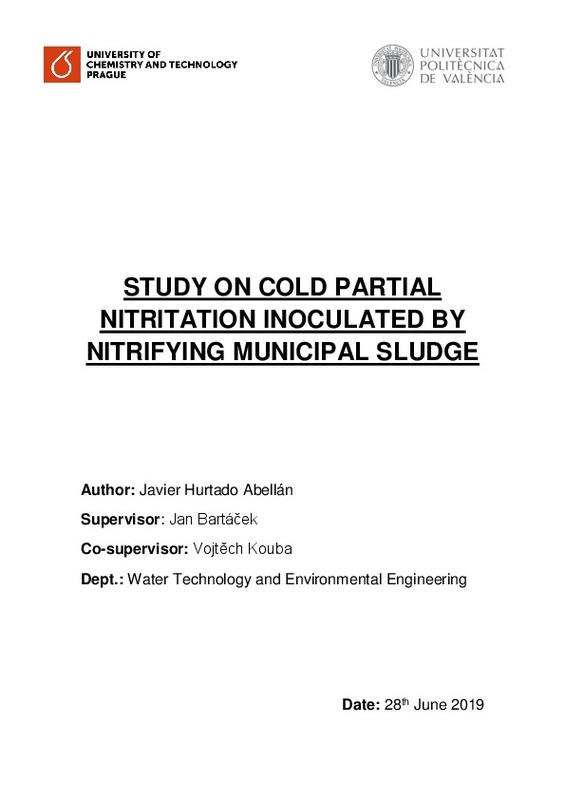|
Resumen:
|
[EN] This thesis develops an alternative process to nitrification/denitrification (N/DN) for
nitrogen removal from municipal sewage at temperatures between 13-26ºC, due to
drawbacks of N/DN systems: high consumption of ...[+]
[EN] This thesis develops an alternative process to nitrification/denitrification (N/DN) for
nitrogen removal from municipal sewage at temperatures between 13-26ºC, due to
drawbacks of N/DN systems: high consumption of energy and organic carbon, and
production of a great amount of sludge. The partial nitritation (PN) start-up from fully
nitrifying municipal sludge was studied through a pilot-scale sequencing batch reactor
(SBR) fed with contaminated tap water by ammonium sulfate ((NH4)2SO4), which
simulated real sewage from anaerobic digestion. The analysis of the samples by using
several tests (nitrogen test, kinetic test and volatile suspended solids test) and the control
of certain parameters (pH, dissolved oxygen (DO), ammonium concentration in the
influent (TAN), etc.) were carried out to keep the process under stable conditions and to
know the system behaviour in the nitrogen removal at low temperatures. The final
challenge was to generate a suitable effluent for the subsequent anammox step with an
ammonium conversion between 50-57% and a high suppression of the activity of nitrite
oxidizing bacteria (NOB) by the growth of ammonium oxidizing bacteria (AOB), the
limitation on the duration of the aerobic SBR phase and the control of the solid retention
time (SRT).
After an exhaustive analysis of the results, the success of the research was
confirmed since the effluent from the pilot plant showed an acceptable NOB inhibition
with an average nitrite accumulation (NAR) of 89% and a partial conversion of
ammonium to nitrite through a final ammonium nitrogen conversion between 41-62%
and a N-NO2
-
/N-NH4
+ ratio of 1.20±0.30; in spite of a low NOB activity in the reactor and
the loss of biomass due to excess sludge washout in the effluent. To overcome these
small limitations in the future, several improvements have been suggested. On the basis
of the above, this study provides a good background for the next research on the
anammox reaction at low temperatures, which is going to be carried out by the
Department of Water Technology and Environmental Engineering of University of
Chemistry and Technology (UCT) from Prague (Czech Republic).
[-]
[ES] Esta tesis desarrolla un proceso para eliminación de nitrógeno de agua residual municipal a bajas temperaturas (13-26 ºC). En este proyecto, se estudia la puesta en marcha de la nitritación parcial a partir de lodos ...[+]
[ES] Esta tesis desarrolla un proceso para eliminación de nitrógeno de agua residual municipal a bajas temperaturas (13-26 ºC). En este proyecto, se estudia la puesta en marcha de la nitritación parcial a partir de lodos municipales totalmente nitrificantes (pH, rendimiento de operación, temperatura, sólidos suspendidos, etc.) para producir un efluente apropiado para el posterior anammox y remplazar la nitrificación/desnitrificación con mayor consumo energético en el tratamiento de agua residuales.
[-]
|







